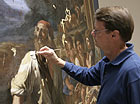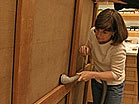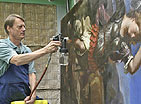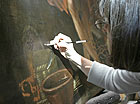Treatment Steps
The proposed stages of treatment for Guercino's Erminia and the Shepherds are as follows:
  
- Conservation always begins with a thorough examination by a paintings conservator, followed by written reports that document the painting's present condition and make proposals for treatment. Photographs are taken before, during, and after treatment, to visually document the painting's condition and the progress of the project.
- Treatment begins with the removal of dirt, grime, and other accretions from the varnish layer by means of aqueous solutions. Then the discolored natural resin varnish is reduced with chemicals that will not harm the original paint layers. Finally, the distracting, discolored retouching and overpainting in oils, from previous restorations, are reduced or removed.
- The next step is to clean the reverse of the canvas of dirt, dust, and debris. Necessary repairs are made to the tacking edges, and the stretcher is adjusted ("keyed-out") to place even, proper tension on the canvas.
 
- Attention now returns to the cosmetic problems. A nonyellowing, stable synthetic resin varnish is applied to the painting.
- Losses in the paint and ground layers are filled and textured to match the surrounding original paint layers. Losses are inpainted with a stable, nonyellowing, nondiscoloring synthetic medium.
- A protective backing board is secured to the reverse of the stretcher to keep out dirt and debris, prevent impact damage, and enhance the stretcher's structural stability. The painting is now ready to be reframed and hung in the museum's gallery.
As the final step, the conservator writes a report detailing all aspects of the treatment.
|
